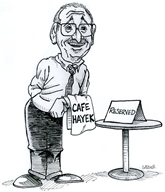In sum, I completely agree with EB that it would be good if appellate courts struck down Trump’s IEEPA tariffs under the nondelegation doctrine. Indeed, I have said as much since my very first piece on the subject, back in February (the post that eventually led to the filing of our case).
But there are also multiple additional reasons to rule against the tariffs, including 1) IEEPA doesn’t authorize tariffs at all, 2) trade deficits are not an “emergency” or an “unusual and extraordinary threat” 3) deficit-related tariffs are now governed by the Trade Act of 1974 (a point noted by the CIT), not IEEPA, 4) the major questions doctrine, and 5) constitutional avoidance (relied on by both CIT and Judge Contreras). We cover all these in much more detail in our Federal Circuit brief.
These two letters in today’s Wall Street Journal are excellent:
Phil Gramm and Donald J. Boudreaux finely catalogue the effects of the first Trump administration’s experiment with protectionism (“These Are Trump’s Worst Tariffs,” op-ed, June 26). The first George W. Bush administration is instructive too. After the White House levied tariffs on steel imports, U.S. manufacturing lost more than 400,000 jobs between March 2002 and March 2003, according to the Bureau of Labor Statistics. Manufacturers were unable to pass along higher prices to their customers thanks to fixed price contracts.
The most overlooked consequence of the tariffs was their effect on the stock market. The Dow Jones Industrial Average reached a post-Sept. 11, 2001, peak on March 19, 2002, at 10,635.25. The steel tariffs took effect the next day. Lumber tariffs followed in May. The Dow didn’t recover until the steel tariffs were lifted on Dec. 4, 2003. From March 2002 to May 2003, the S&P 500 lost $2 trillion in market cap.
Higher input costs result in lower earnings. The market meltdown this spring was a warning. The president ignores the lesson at the nation’s peril.
David R. Breuhan
Bloomfield Hills, Mich.As you note in your editorial “‘Tariff Man’ Is Back for More ‘Liberation’” (July 8), President Trump is doubling down on a failed a idea. In doing so, he’s rejecting his first-term playbook.
That governing agenda was characterized by broad tax cuts and deregulation coupled with narrowly applied tariffs. The combination unshackled American workers and allowed them and the economy to flourish. This term, however, many of the tax-cut and deregulation efforts have been narrow, while tariffs have been broadly and inconsistently applied. The levies are being used for a myriad of reasons, from industrial policy and raising revenue to retaliating against Brazil for the government’s treatment of its former president. This saddles American producers with higher costs for critical materials, hurting manufacturers and consumers with higher prices.
American workers are strong enough to compete on the world stage. They need empowerment, not protection. What’s standing in their way isn’t foreign competition but government regulation.
David Hebert
American Inst. for Economic Research
The Editorial Board of the Wall Street Journal ponders the recent uptick in reported inflation. A slice:
Let’s stipulate that tariffs don’t cause inflation, which is an increase in the general price level. Inflation occurs when there is too much money chasing too few goods and is usually the result of monetary-policy mistakes.
But tariffs are taxes, and they do raise prices on the goods on which they’re applied. Those price increases may be a one-time event, depending on the tariff and how supply-chains are affected. But Americans who experience those rising prices will still notice the decline in their purchasing power.
And that’s what they’re seeing in the June inflation report. Price increases were broad-based, and especially in goods that the U.S. imports. Think toys (1.8%), paper products (1.4%) and appliances (1.9%). The latter was the biggest increase since August 2020.
On July 11th, Richard Baldwin asked: “Why did Trump backdown from his 2 April 2025 threats this week?” (HT David Levey)
If lawmakers care as much about housing costs, energy prices, climate change, domestic manufacturing and economic growth as they claim, Congress should take a cue from a big ruling in the Supreme Court’s latest term.
The way things were going, building a highway, or maybe even fixing a street, might have been stopped in court on the grounds that it could encourage the production of more cars running on internal combustion engines and hence contribute to climate change. To the chagrin of some environmental groups, the Supreme Court thankfully curbed the increasingly absurd abuse of the 1970 National Environmental Protection Act (NEPA) to block all sorts of building — including projects crucial to protecting the environment. From here, Congress should ease construction of critical infrastructure even further.
Jeffrey Miron and Jacob Winter explain that “immigrants benefits US-born entrepreneurs.”



